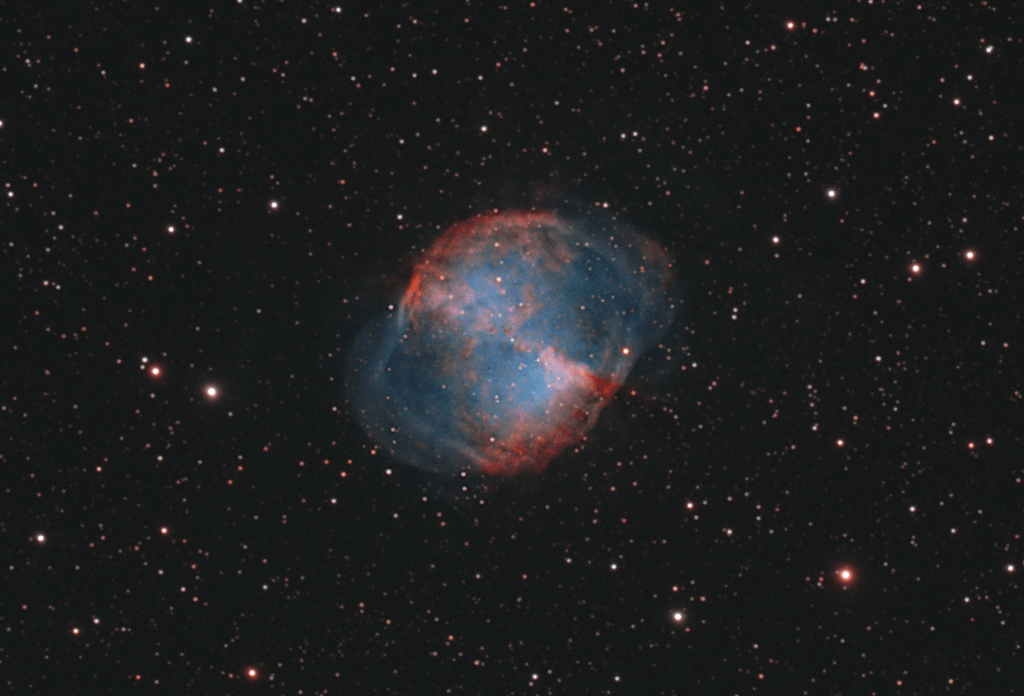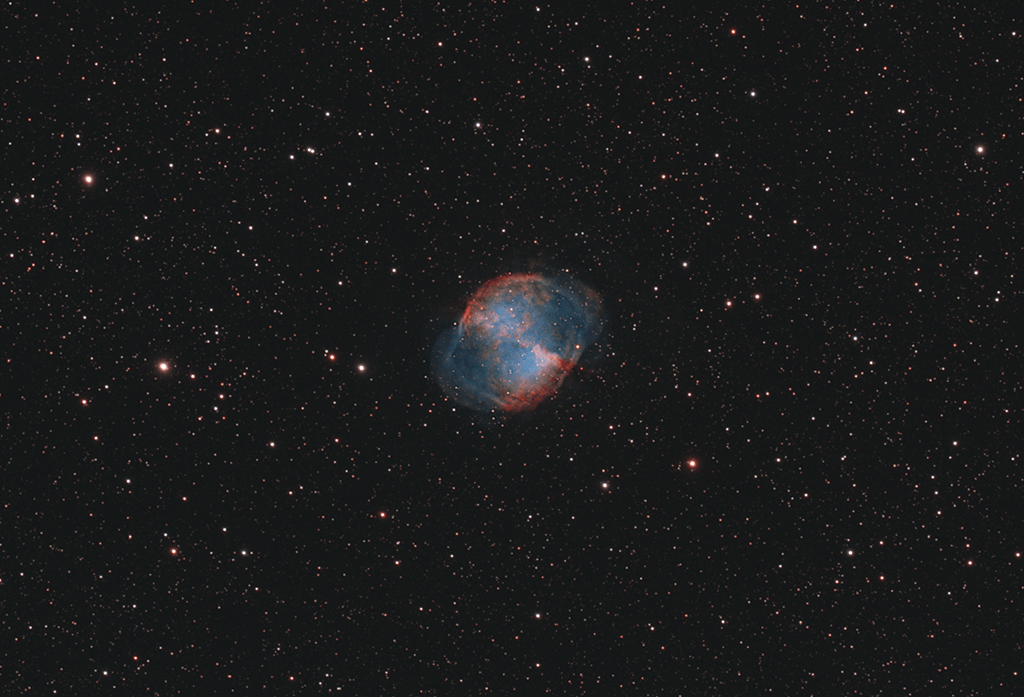The Dumbbell Nebula is a planetary nebula. It is not related to planets at all, however, and is actually an expanding shell of ionised gas ejected from a red giant star. Red giant stars eventually become white dwarfs, like the one at the centre of this photograph. Stars which are not large enough to become a neutron star or black hole end up as white dwarfs, and our own sun is thought to be in this category.
Relatively speaking, the Dumbbell Nebula is quite small and bright. It appears to us as about a quarter of the diameter of the full moon, and it only occupies a small region of the camera sensor, as shown in the uncropped image below. And being bright makes it a relatively easy astrophotography target, which is just as well seeing as I could only get 2 h on it with both clear sky and dark(ish) sky together.
I’ve been forced off astrophotography for a few weeks (since 7 June), when my astronomy camera developed a fault and I had to send it off to Altair for a service. I think it developed an internal USB connection problem (at the camera end); however, Altair, incredibly, just replaced it with new, so I didn’t get a confirmed diagnosis. Needless to say, I’m extremely happy with this outcome. I was a bit worried that, as an ex-display camera, it would be considered as out-of-warranty.
SharpCap 4
SharpCap 4 is now out of beta, so I ran the release version for the first time for this project, using sequencing and autofocusing. I also remotely operated everything over wifi via my new Hystou mini PC, which sits on a table next to the mount. I will eventually attach the mini PC to the mount under the telescope, allowing for even shorter and tidier cables!
My SharpCap 4 sequence below loads one of my typical deep sky profiles in RAW14 with exposures of 150 s, an analogue gain of 900, and a black level of 99. It then loops, starting with autofocusing between +250 and -250 steps of the current position in 10 increments, followed by capturing 20 light frames with a dithering step every 2 frames (every 300 s), while guiding.
SEQUENCE
LOAD PROFILE "Deep Sky 150 s (AA294CPRO)"
GUIDING CONNECT ABORT False
TARGETNAME "Dumbbell Nebula M27"
LOOP 20 TIMES
PRESERVE CAMERA SETTINGS
FOCUSER CONNECT
SET EXPOSURE TO 2
SET GAIN TO 72000
AUTOFOCUS OFFSET 250 TO -250 STEP COUNT 10 BACKLASH 2000
END PRESERVE
PRESERVE CAMERA SETTINGS
FRAMETYPE Light
GUIDING DITHER EVERY 300
CAPTURE 20 FRAMES REQUIREGUIDING True
GUIDING DITHER EVERY STOP
END PRESERVE
END LOOP
END SEQUENCEFrames
- 52× 150-s light frames (Gain 900)
- 2 h 10 min total exposure time
- Full use of calibration frames (darks, flats and dark flats)
Equipment
- Explore Scientific ED 102 mm Apo f/7 refractor
- Revelation Adjustable Field Flattener
- Sky-Watcher EQ6-R PRO SynScan GOTO equatorial mount
- Altair Hypercam 294C PRO colour fan-cooled camera
- Altair quad-band one-shot colour (OSC) 2″ filter
- Pegasus FocusCube v2
- Altair 60mm guide scope
- Altair GPCAM2 AR0130 mono guide camera
- Hystou Rugged Fanless Mini PC i5 7260U
Software
- SharpCap 4.0
- PHD2
- DeepSkyStacker
- Photoshop




